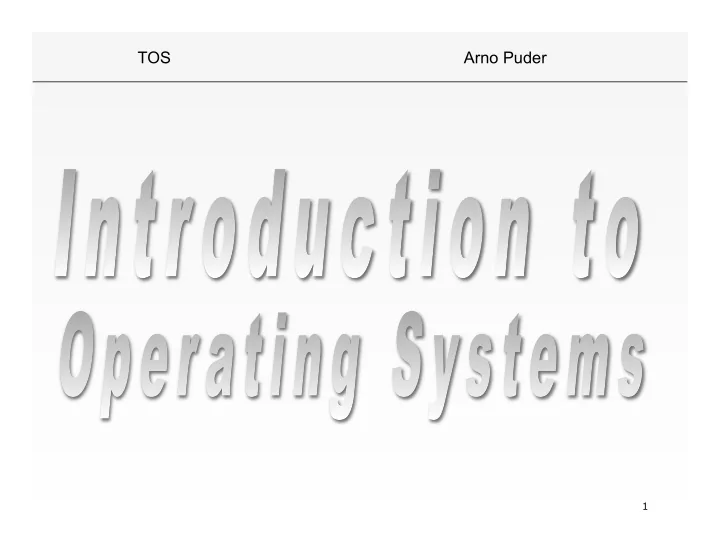

TOS Arno Puder 1
What is an OS? • A program that acts as an intermediary between a user of a computer and the computer hardware. • Operating system goals: – Execute user programs and make solving user problems easier. – Make the computer system convenient to use. • Use the computer hardware in an efficient manner. 2
Computer System Components 1. Hardware – provides basic computing resources (CPU, memory, I/O devices). 2. Operating system – controls and coordinates the use of the hardware among the various application programs for the various users. 3. Applications programs – define the ways in which the system resources are used to solve the computing problems of the users (compilers, database systems, video games, business programs). 4. Users (people, machines, other computers). 3
Abstract View of System Components 4
PC Architecture Memory Local Bus RAM CPU ROM D Hard Disk A T Network A Card B U Printer S Controller Keyboard Serial Line 5
CPU Top view of CPU chip Bottom view of CPU chip 6
Integrated Circuits 7
CPU Partial die shot of the Intel 386 microprocessor using a variety of colors to show the bonding wires and bus connections using oblique illumination with red, yellow, and blue gels. 8
PC Motherboard Main Memory CPU Lithium battery Video Adapter PCI Expansion Interface 9
Ethernet Network Card 10
The Storage Hierarchy • Registers – storage immediately accessible within the CPU • Main memory – only large storage media that the CPU can access directly. • Secondary storage – extension of main memory that provides large nonvolatile storage capacity. • Magnetic disks – rigid metal or glass platters covered with magnetic recording material 11
Storage-Device Hierarchy 12
Data Migration From Disk to Register 13
Moving-Head Disk Mechanism 14
Abstract View of System Components 15
Some Terms • Bus: electronic circuit that connects devices so that they may exchange data. – Examples: PCI, USB • Kernel: The “ program ” that runs directly on the computer hardware, managing the hardware for multiple applications – Note: kernel is NOT the same as the user interface 16
What is an OS revisited • When comparing OS ’ s we tend to think about the user interfaces. • In this course, we focus on the OS kernel: what it does and how it does it. 17
Kernel Tasks • The kernel ’ s job is to manage hardware resources to provide: – Sharing – Protection – Convenient abstractions for applications 18
Examples of Kernel Tasks • Manage the CPU: pre-emptive scheduling • Manage memory: Virtual Memory • Manage disks: File Systems • Manage network: sockets • Manage other peripherals (keyboard, display, sound card) 19
Recommend
More recommend